People who encounter this skin disease for the first time, which has very unpleasant symptoms, want to know what psoriasis is and how to get rid of this disease.This is a disease that primarily affects the upper layer of the epidermis and its appendages: nail plate and bed, hair.According to statistics, psoriasis affects about 4% of the total world population.Moreover, the disease is more common at a young age: from 18 to 23 years old.
There are many diseases similar to psoriasis, so it is important to know its symptoms in order to choose the right treatment.

In general, you should not self-medicate this disease, because psoriasis develops very quickly and can cause serious complications.Visiting a dermatologist is the only correct decision if you discover signs of the disease.
Species
There are many variants of this skin disease.When classifying psoriasis, the nature of the rash, the severity of the course and the location of the lesions are taken into account.There are the following main types of psoriasis:
- Plaque psoriasis (common).This is the most common type of disease, occurring in 85% of all patients.It is characterized by the presence of grayish or silver-white plaques raised above the surface of the skin, which peel off easily.Vulgar psoriasis is another name for this form of the disease.
- Guttate psoriasis.Harmful elements in this type of disease resemble droplets or dots from red to purple.
- Pustular psoriasis.The most severe form of this skin disease.It is characterized by the presence of pustules on the body - vesicles filled with clear, non-infected fluid.When the disease progresses, the fluid becomes purulent.
- Psoriatic nail damage (onychodystrophy).Symptoms of psoriasis of this form affect the nail plates and the area around them: the shade of the nail changes, spots appear on its surface, the skin around the bed thickens, the plate breaks and delaminates.
- Arthropathic psoriasis.The disease is characterized by inflammation of small joints.This form of psoriasis most often leads to disability.
- Inverse psoriasis (fold or inverse).The disease affects skin folds in the groin area, on the inner side of the thighs, armpits and under the mammary glands (in women).
- Palmoplantar psoriasis.With the development of this form of the disease, all characteristic symptoms begin to appear on the feet and hands.In severe cases, the disease affects the nails and other parts of the body.
- Seborrheic psoriasis.In this form, the rash is localized on the head, face and back.
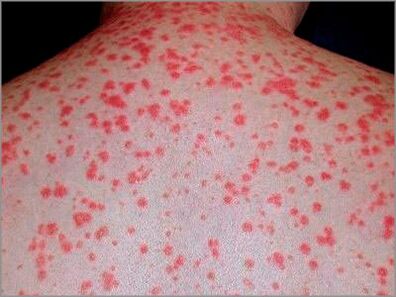
Symptoms of the disease
What does psoriasis look like?How not to confuse it with another skin disease?In the initial stage of the disease, the following signs of psoriasis appear:
- the appearance of pink, red or bluish papules on the skin, symmetrically located in certain parts of the body;
- general weakness;
- chronic fatigue;
- depression or apathy.
Gradually, the rash merges into plaques - scaly formations that are easily removed.The area of inflammation grows towards the edges.
At this stage of psoriasis, there are signs that can help distinguish the disease from other skin conditions.If you scrape off the scales, you can observe the phenomenon of the psoriatic triad, formed by the following symptoms:
- stearic stain: after scraping the plaque, silvery-white flakes resembling stearic shavings are separated;
- terminal film: a very thin glossy film covering the papule remains at the site of the scraped formation;
- "bloody dew": at the site of the removed terminal film, precise bleeding may appear, which is caused by injury to the subcutaneous vascular network.
Symptoms of psoriasis vary depending on the specific stage of the disease and the season.In most patients, the manifestations of psoriasis intensify in winter.The "summer" form of the disease is quite rare, because the patient's condition improves under the influence of ultraviolet radiation.
How does psoriasis manifest itself in different stages?In total, there are 3 stages of disease development.
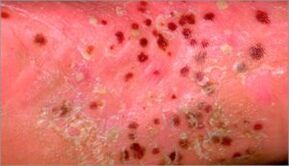
- In the progressive phase, new rashes constantly appear, and existing plaques increase in size.The patient feels severe itching, the skin constantly peels.
- What does psoriasis look like in the stationary stage?During this period, papule growth stops.Small folds are observed in the area of the plaques.There is still intense itching.
- In the regression phase, the plaques begin to disappear, the peeling disappears, and the itching stops bothering.Pigmented areas may appear at the site of formations.
Some types of psoriasis have characteristic symptoms.
For example, when the scalp is affected, dandruff-like plaques appear first.In this case, only the skin suffers;the condition and growth of the hair is not affected by the disease.From the head, the rash spreads to the area behind the ears, neck and forehead.
The appearance of psoriasis on the palms and feet is accompanied by thickening of the skin and the appearance of cracks.In the initial stage of the disease, pustules with transparent contents are formed, which gradually become purulent.Later, scars appear at the site of such formations, which cause discomfort and pain during physical activities (working with hands, walking).In the future, the disease may spread to the back of the hands and fingers.
Psoriasis of the nails has the following description: first of all, the plate is covered with small depressions, which resemble needle marks, changes color, begins to peel and peel.The tissue around the nail becomes thick and inflamed.
The main reasons
The pathogenesis of psoriasis has not been fully studied to date.Scientists have put forward several theories as to why this disease occurs.There are two main causes of psoriasis.
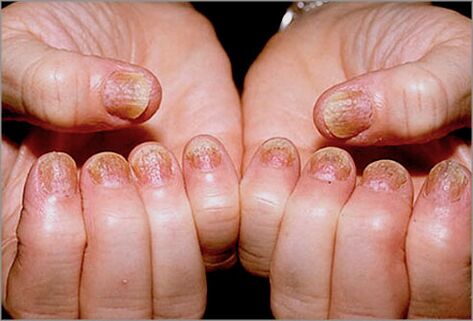
- The causes of the disease are malfunctioning of the immune system.Cells that are designed to protect the body from bacteria and viruses enter the upper layer of the epidermis, where they produce substances that trigger the inflammatory process.Because of this, skin cells divide rapidly, and the affected area thickens.This theory is supported by a study of psoriatic plaques, which revealed a large accumulation of immune cells.
- The skin disease psoriasis is caused by disturbed division and maturation of epithelial cells.As a result of this pathology, the immune cells attack the diseased skin cells.
The development of psoriasis is influenced by a number of factors.The risk of disease increases if the body is simultaneously affected by several of the following conditions.
- Having dry and thin skin.Experts have noted that people with thick, oily and hydrated skin rarely suffer from psoriasis.This is due to the structural characteristics of the epidermis and the protective functions of sebum.
- Excessive love for hygiene.Unjustified desire to constantly keep the body clean, too frequent use of soap and cloths for washing damages the skin and reduces its protective properties.
- Bad habits.When smoking and drinking alcohol, the condition of the epidermis worsens: subcutaneous blood circulation and tissue nutrition are disturbed.
- Negative external factors.According to statistics, skin diseases occur more often in those who regularly come into contact with detergents, household chemicals, alcohol solutions, etc.
- Medicines.Chronic use of certain medications, for example, antidepressants, anticonvulsants, can cause psoriasis symptoms.
- Infectious diseases.Often the pathology appears immediately after a disease caused by a fungus or staphylococcus.
- Climate change.It happens that moving to another climate zone is enough to develop psoriasis.
- Skin injury.Constantly wearing uncomfortable clothes with rough seams or low-quality shoes, the habit of scratching the same area can cause the first symptoms of psoriasis to appear.
- Stress.Both psychological and physical (for example, long-term hypothermia) body shocks can precede the appearance of the disease.
- Severe eating disorders.The course of the disease can be complicated by the abuse of sweet food, carbonated drinks, citrus fruits, smoked meat, salty food.
- Genetic predisposition.Is it possible to inherit psoriasis?According to scientists, the genes responsible for the activity of the immune system are carriers of the disease.Because of this, the disease is transmitted from parents to children.
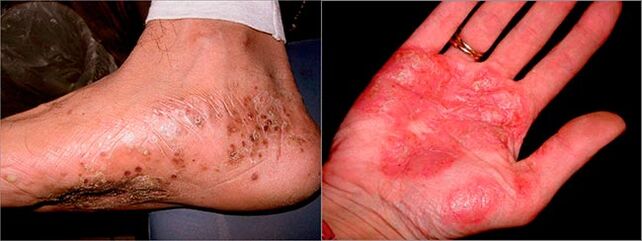
Life of patients with psoriasis
Despite the fact that psoriasis is not a contagious disease and cannot be transmitted through physical contact with the patient, many patients consider themselves outcasts from society, which is why they experience severe psychological discomfort.
The biggest problem is the presence of rashes on the head, ears and face. More than half of patients constantly concentrate on their appearance and are afraid of public condemnation and rejection by society, because psoriasis often looks like ringworm.As the disease progresses, the person limits communication with people.Only a quarter of psoriasis sufferers do not experience stress due to their appearance.
The disease also causes severe physical discomfort.Constant itching and burning limit the patient's ability to work, interfere with proper rest, often cause insomnia and interfere with exercise.Psoriatic arthritis adds pain in the joints to the unpleasant symptoms.
Psychological anxiety combined with physical discomfort can cause severe depression, and some patients even experience social phobia.Long-term and expensive treatment of the disease also has a negative effect on the patient, additionally takes away strength and hinders his socialization.
Why is psoriasis dangerous?
In the initial stage, the disease causes a person discomfort associated with the manifestation of symptoms: itching, burning, peeling.
If psoriasis is not treated, it progresses, which is dangerous for the health and even the life of the patient.
In many cases, the following dangerous complications develop:
- pathological changes occur in metabolic processes;
- heart function deteriorates, there is a risk of stroke, myocarditis;
- there are disorders in the work of the kidneys and liver;
- the joints are affected (most often the phalanges of the fingers, elbows, knees);
- mucous membranes are affected: eyes, gastrointestinal tract, bladder;
- as a result of severe psoriasis, the brain and nervous system are affected;
- potency may weaken in men;
- due to the spread of plaques on the skin, the respiratory function of the skin and the activity of the sweat and oil glands are disturbed;
- thermoregulation is disturbed, which leads to inflammation of the epidermis, which can cause blood poisoning and, as a result, death.
Erythroderma can be a consequence of worsening of the disease.
This complication occurs in only 2% of all patients.In the initial stage, it is characterized by the appearance of bright red lesions on the skin, reminiscent of burns.Over time, scales appear on such areas, which peel off in large layers.The skin in this area becomes hot and very sensitive.Other symptoms also appear: a feeling of tightness, constant itching, brittle nails, severe hair loss, enlarged lymph nodes.
If you discover signs of psoriasis, consult a dermatologist immediately.The formulation of the diagnosis is based on an external examination of the skin and nails.As a rule, additional tests are not prescribed.If the patient complains of joint pain, an X-ray and blood tests are done to rule out other types of arthritis.
Only a doctor can make a correct diagnosis and decide how to treat psoriasis.
Treatment methods
It should be noted right away that psoriasis cannot be completely cured.
Winston Churchill also said: "I will raise a monument of pure gold to the one who can learn all about psoriasis and find an effective cure for this disease."
External preparations
Regardless of the causes of psoriasis, first of all, the doctor prescribes local medications that help relieve unpleasant symptoms.First, non-hormonal lotions, ointments and creams are used, which contain tar, oil, zinc or medicinal herbs.In most cases, such drugs help to forget about the unpleasant signs of psoriasis after 3-4 weeks of use.
If non-hormonal ointments are ineffective, hormonal psoriasis medications are used.They must be used strictly as prescribed by a specialist, in no case exceeding the dose or increasing the course of treatment.With the help of hormonal ointments, you can quickly forget what it is - psoriasis, but there is a high risk of serious side effects.
Even the latest topical drugs must be used in combination with other drugs.In addition to fat, enterosorbents are prescribed that will remove toxic substances from tissues and immunosuppressants, designed to reduce the reaction of the immune system.Treatment is impossible without taking vitamin complexes, especially vitamins B, A, C, D.
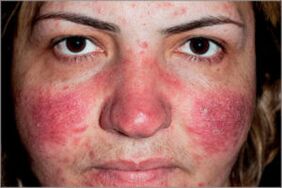
Physiotherapy
These methods of treating psoriasis are widely used in all stages of the disease.Such procedures as baths, phototherapy and ultraviolet radiation give excellent results.
New methods of treating the disease include cryotherapy, electrosleep, hirudotherapy and PUVA therapy.
In advanced forms of the disease, the use of ultraviolet light has a good effect.Thanks to this method, in just 20-30 procedures, damaged cells are destroyed, peeling is eliminated, damaged skin is restored, and the immune system returns to normal.Before performing the entire procedure, a trial session is conducted, exposing a small part of the patient's body to the rays.If the skin reaction is normal, the full course is prescribed.In the summer, the patient is offered a continuation of the ultraviolet treatment under the natural rays of the sun.
Traditional medicine
Folk remedies for any type of psoriasis can be used only in consultation with a doctor.
It is important to understand that severe psoriasis symptoms cannot be eliminated at home.
Traditional recipes only help to soften the peeling skin and temporarily relieve itching.The following products received the best reviews among patients.
tar:
- in the first days from the onset of the disease, apply tar to the affected areas with a cotton swab for 10 minutes, then wash with tar soap;
- 4-5 days, increase the duration of the procedure to 40 minutes;
- the full course of treatment is 12 days;
- It is better to use tar before going to bed, because its smell completely disappears during the night.
celandine:
- pass through a meat grinder a few bushes of celandine, uprooted;
- Squeeze the juice from the resulting mass;
- lubricate each affected area of the body with juice;
- repeat the procedure until the external signs of the disease disappear completely.
Eggs and vinegar:
- prepare the fat by whisking 2 eggs and 20 ml of vegetable oil;
- add 10 ml of acetic acid to the mass;
- Apply the resulting product to the rash and deposits every evening;
- course of treatment: 3-4 weeks.
Herbs:
- Grind 20 g of St. John's wort, 20 g of celandine root, 10 g of calendula flower and 10 g of propolis into a paste (it is better to do this in a clay pot);
- add 20 ml of vegetable oil to the medicinal herbs;
- Apply the prepared product to the affected areas three times a day;
- You can stop the treatment as soon as the visible signs of the disease disappear.
Elderberry infusion:

- Pour 10 g of elder leaves and flowers with 0.5 liters of boiled water;
- leave the infusion in room conditions for half an hour;
- take 80 ml of the infusion every time the itching increases after eating;
- course of treatment - 10 days.
Diet
Whatever psoriasis treatment methods are used, without following a special diet, it will not be possible to achieve much improvement.To adjust the diet, it is better to contact a specialist who will create a menu taking into account the individual characteristics of a particular patient.In order to ensure that the entry "psoriasis" no longer appears in the medical history, you should know and follow the general rules of nutrition for patients.In the case of this disease, the following should be excluded from the menu:
- any nuts;
- citrus fruits;
- smoked meat;
- spices;
- salinity;
- spicy dishes;
- fatty foods;
- alcohol;
- blue cheese.
If your medical history includes a diagnosis of psoriasis, you must ensure that your diet is balanced.Every day, there should be foods on the table that supply the body with all the necessary substances.
It is especially important to get fatty acids that all types of fish contain in sufficient quantities.
Recommendations for the patient
In order to forget for a long time what kind of disease was bothering you, regardless of what type of psoriasis you have, follow these important rules during and after treatment:
- use gentle skin care: wash with warm water and a neutral product, do not rub the body with a towel, but gently wipe it;
- give up ordinary cosmetics for a while, avoid using products that are new to you;
- When doing any household work, wear protective gloves;
- limit contact with allergens;
- wear clothes and shoes made of natural fabrics without rough seams;
- drink at least 1.5 liters of clean water a day.
You must understand that it is impossible to completely cure psoriasis.However, if you choose the right means to fight this disease, you can get rid of its unpleasant symptoms and achieve a stable remission.
Keep the skin clean, pay attention to the slightest changes in its condition, and if you have suspicious symptoms, consult a specialist.Taking care of your own body will allow you to always stay healthy and beautiful.In order to stay up to date with interesting information and current news, subscribe to our articles and be sure to share them with your friends on social networks.See you again!
This article has an exclusively educational, encyclopedic and informative function.Before using the tips and recommendations described in this article, you should get your doctor's approval.Do not self-medicate!
























